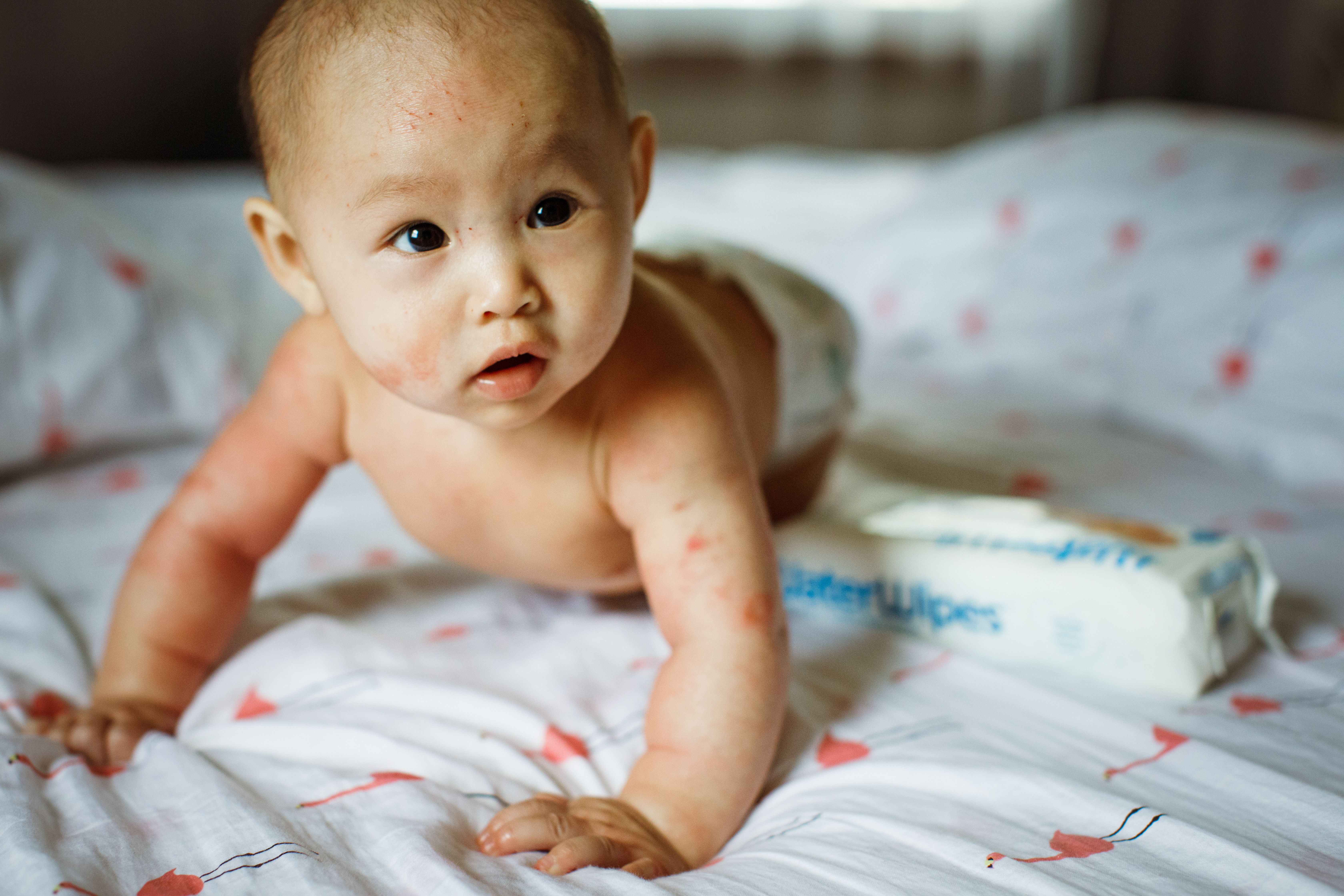Article
Atopic Dermatitis Prevention: Evidence-Based Infant Skin Care for the Primary Care Office

Atopic dermatitis (AD) is one of the most common skin conditions managed by primary care clinicians.1 For doctors who care for infants and children, early education in skin care management is vital for the long-term success of patients who struggle with AD and sensitive skin. Eczema Awareness Month is a prime opportunity to equip our patient care teams with evidence-based skin care advice and tips for AD prevention.
Nearly all pediatricians can identify the red, itching rash of AD. Despite this intimate clinical familiarity, the exact cause of AD is unknown. Research has clearly shown a strong association with family history and over 45 genes are implicated in AD.2 However, the heritability of the disease is largely unexplained. Research has also suggested structural deficits and a disordered immune response as causes of AD, but these have never been proven.2 Regardless of the primary cause, patients with AD share the consequences of a complex interaction between internal and external factors that result in a poorly functioning outer skin layer.
The abnormality in patients with AD is a dysfunctional epidermis. Abnormal skin structure and function result in increased water loss, chronic inflammation, increased skin pH, and microbial colonization. In addition, cytokines and other immune modulators interact with neural fibers resulting in chronic itch.3 These changes result in patients with AD experiencing cycles of itching rash with intermittent flares requiring medical care.
Most patients with AD begin to have flares by the age of five years.4 Trouble spots in infancy are the cheeks, scalp, and extensor surfaces of the arms and legs. As kids age, the commonly affected areas are the flexor surfaces of the elbows and knees, ankles, wrists, and neck. Acute flares involve the development of intensely itchy, dry, red papules, and vesicles. Chronic lesions present as thickened skin with altered pigmentation.1 Affected areas change over time due to the natural changes in skin architecture as a person ages.
Infant skin is fully functional at birth but carries some significant differences from mature skin. The transport and distribution of water are notably different in infant versus adult skin, with newborn skin being initially drier and of neutral pH. Over 2-3 months, newborn skin becomes slightly acidic as the acid mantle forms.5 Water-binding factors and free fatty acids increase on the surface of the skin, improving the function of the outermost skin layer as the pH drops. The acid mantle is necessary for proper epidermal function and is influenced by products used on the skin.6
Beginning in the labor and delivery suite, care decisions can promote the development of healthy infant skin. At delivery, term infants are covered in a thick substance called vernix. Vernix is thought to be critical to the development of the outmost skin layer while in utero, as well as protective against the unavoidable insults to newborn skin. Although vernix is primarily water, it also contains enzymes and proteins with antimicrobial and water-binding properties. Due to these protective factors, it's recommended that vernix stays on infant skin for at least six hours after birth. Gentle dry wiping after birth allows some vernix to remain in place,7 and delaying the first infant bath until 24 hours of life is preferred.7
Use the right products and timing for infant bathing. Routine bathing can begin after the first week of life without disrupting the skin barrier.4 Infant cleansing products should contain a low amount of surfactants and have a neutral to slightly acidic pH. Most research suggests using a liquid-based, mild synthetic detergent, followed by a thorough rinse.8 Immersion bathing is preferred, but typically avoided until the umbilical stump is gone. However, there is little to no evidence of increased umbilical infection with immersion bathing.7 A quick, warm water bath (less than 10 minutes), 2-3 times per week is typically enough for most babies.
After the bath, maintaining and replacing skin moisture is key to routine care, especially for infants at risk of developing AD. Beginning daily, full-body emollient treatments at three weeks of life is one of the few evidence-based AD prevention strategies.9 Emollients should be fragrance-free and contain few preservatives. Additives like ceramides or colloidal oatmeal may be increasingly helpful to hydrate infant skin and are typically well-tolerated.9 After the bath is the best time to apply emollients, trapping water in the skin while preventing water loss.
Although AD classically spares the warm and humid diaper environment, the presence of debris on sensitive infant skin can lead to breakdown and diaper rash. In addition, friction caused by excessive wiping, or the diaper itself, can damage the skin surface and make the area prone to inflammation and infection. For children with sensitive skin, commercially available disposable diapers are preferred to cloth diapers. Disposable diapers do a superior job removing wetness and maintaining proper skin pH during wear.6
In addition to disposable diapers, parents should be encouraged to use effective diaper wipes and creams. Diaper wipes with minimal ingredients, like WaterWipes, are preferred to diaper wipes containing surfactants or other unnecessary ingredients. In a large clinical trial, babies cleansed with wipes with the fewest ingredients had less incidence of diaper rash and shorter duration of the rash.10 In turn, WaterWipes was awarded the National Eczema Association seal of acceptance. Finally, applying a barrier ointment or zinc-based diaper cream will protect infant skin from the chemicals in the urine and feces that begin skin breakdown, preventing skin damage that makes babies prone to diaper rash.
Above all else, one of the most powerful care tools for patients with AD is education. At every well visit, reinforcing the message to parents about routine skin care will help families maintain skin integrity and limit AD flares. Providing a written plan for families augments the office conversation and solidifies verbal instruction. Free AD plans to use with patients and their families are available online from reputable organizations, such as the American Academy of Allergy, Asthma & Immunology11 and the American Academy of Dermatology.12
Education is not just for the exam room. Our patients need support from all members of our care teams, including the nurses who help with in-office or phone advice. Keeping the medical team up-to-date with current recommendations helps all patients receive a consistent and accurate skin care message. A free, one-hour course on infant skin care is available online from the WaterWipes Healthcare Academy. The course features evidence-based infant skin care recommendations and information on the most common infant rashes seen in the primary pediatric office. This CE-accredited course is ideal for clinical nursing teams, care providers, and interested parents.
Healthy skin care is important for all infants, especially those at risk for AD. Providing evidence-based education to families and caregivers about care for this chronic condition, including best practices and products for bathing and diapering. Additionally, every office visit is an opportunity to remind families about the importance of limiting irritants and replacing skin moisture to prevent AD flares. The efforts of every member of the health care team will ensure each patient has the tools needed for a lifetime of healthy skin.
Dr. Natasha Burgert is a board-certified pediatrician who practices at Pediatric Associates in Overland Park, KS. She is also a spokesperson for the American Academy of Pediatrics and routine contributor to Forbes Health. She also serves as a medical advisor for WaterWipes.
Sources Referenced:
1.Fishbein AB, Silverberg JI, Wilson EJ, Ong PY. Update on Atopic Dermatitis: Diagnosis, Severity Assessment, and Treatment Selection. J Allergy Clin Immunol Pract. 2020;8:91-101.
2.Waldman AR, Ahluwalia J, Udkoff J, Borok JF, Eichenfield LF. Atopic Dermatitis. Pediatr Rev. 2018;39:180-193.
3.Oetjen LK, Mack MR, Feng J et al. Sensory Neurons Co-opt Classical Immune Signaling Pathways to Mediate Chronic Itch. Cell. 2017;171:217-228.e13.
4.Gerner T, Haugaard JH, Vestergaard C et al. Disease severity and trigger factors in Danish children with atopic dermatitis: a nationwide study. J Eur Acad Dermatol Venereol. 2021;35:948-957.
5.Blume-Peytavi U, Hauser M, Stamatas GN, Pathirana D, Garcia Bartels N. Skin care practices for newborns and infants: review of the clinical evidence for best practices. Pediatr Dermatol. 2012;29:1-14.
6.Visscher MO, Adam R, Brink S, Odio M. Newborn infant skin: physiology, development, and care. Clin Dermatol. 2015;33:271-280.
7.Johnson E, Hunt R. Infant skin care: updates and recommendations. Curr Opin Pediatr. 2019;31:476-481.
8.Blume-Peytavi U, Cork MJ, Faergemann J, Szczapa J, Vanaclocha F, Gelmetti C. Bathing and cleansing in newborns from day 1 to first year of life: recommendations from a European round table meeting. J Eur Acad Dermatol Venereol. 2009;23:751-759.
9.Silverberg NB. Atopic dermatitis prevention and treatment. Cutis. 2017;100:173;177;192.
10.Price AD, Lythgoe J, Ackers-Johnson J, Cook PA, Clarke-Cornwell AM, MacVane Phipps F. The BaSICS (Baby Skin Integrity Comparison Survey) study: A prospective experimental study using maternal observations to report the effect of baby wipes on the incidence of irritant diaper dermatitis in infants, from birth to eight weeks of age. Pediatr Neonatol. 2021;62:138-145.
11. Aaaai.org. 2021. [online] Available at: <https://www.aaaai.org/Aaaai/media/MediaLibrary/PDF%20Documents/Libraries/AtopicDerm-English.pdf> [Accessed 4 October 2021].
12.aad.org. 2021. [online] Available at: <https://assets.ctfassets.net/1ny4yoiyrqia/ZPT1WHhZHcxlpbDgq3hZX/3973a527e55d064306e40509d5004bb7/eczema-action-plan.pdf> [Accessed 4 October 2021].





